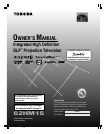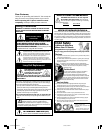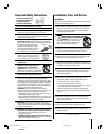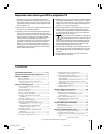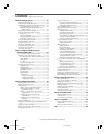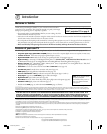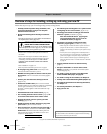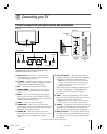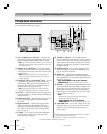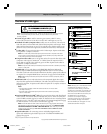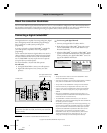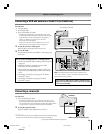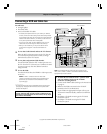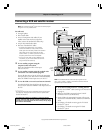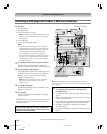
62HM15
Copyright © 2005 TOSHIBA CORPORATION. All rights reserved.
5
Contents
Important Safety Information ............................................. 2-4
Important notes about your DLP™ projection TV...............5
Chapter 1: Introduction .......................................................... 7
Welcome to Toshiba ........................................................... 7
Features of your new TV .................................................... 7
Overview of steps for installing, setting up, and
using your new TV .......................................................... 8
Chapter 2: Connecting your TV ............................................ 9
TV front touchpad and side panel controls
and connections ............................................................. 9
TV back panel connections ................................................ 10
Overview of cable types ...................................................... 11
About the connection illustrations ...................................... 12
Connecting a digital CableCARD
™
.................................... 12
Connecting a VCR and antenna or Cable TV
(no Cable box) ............................................................... 13
Connecting a camcorder..................................................... 13
Connecting a VCR and Cable box ..................................... 14
Connecting a VCR and satellite receiver ............................. 15
Connecting a DVD player with S-video, a VCR,
and a Cable box.............................................................. 16
Connecting a DVD player with ColorStream
®
(component video) and a VCR ....................................... 17
Connecting two VCRs ....................................................... 18
Connecting an HDMI
™
or a DVI device to the
HDMI input .................................................................. 19
Connecting a digital audio system ...................................... 20
Connecting an analog audio system .................................... 20
Controlling infrared remote-controlled devices
through the TV (IR pass-through) .................................. 21
Connecting IEEE1394 video devices .................................. 22
Using analog-compatible IEEE1394 devices ................... 22
Supported signals ........................................................... 22
Using TheaterNet
™
on-screen device control .................. 22
Connecting an AVHD (external hard drive) or D-VHS
digital recorder ............................................................... 23
IEEE1394 device initialization ....................................... 23
IEEE1394 device management ....................................... 24
G-LINK
®
connection ......................................................... 25
Chapter 3: Using the remote control ................................. 26
Learning about the remote control ..................................... 26
Installing the remote control batteries................................. 27
Using the remote control MODE button to control
your other devices........................................................... 27
Remote Control functional key chart ................................. 28
Programming the remote control to operate
your other devices........................................................... 30
Multi-brand remote control device codes............................ 32
Chapter 4: Menu layout and navigation ........................... 34
Main menu layout .............................................................. 34
Setup/Installation menu layout ........................................... 35
Navigating the menu system ............................................... 35
Chapter 5: TV Guide On Screen
®
setup ............................ 36
Setting up the TV Guide On Screen
®
system ..................... 36
TV Guide On Screen
®
Reminder ....................................... 39
Disabling the automatic TV Guide On Screen
®
program
guide .............................................................................. 39
Important notes about your DLP
TM
projection TV
1) The light source for this TV is a projection lamp unit with a
limited service life. When the lamp wears out, the picture may
become dark or black or the lamp may fail, at which time you
must replace the lamp unit. See “Lamp unit replacement and
care” on pages 98–100.
2) Each time you turn on the TV, it may take several minutes to go
from no picture to full picture brightness.
3) The display on this TV is manufactured using a chip that may
contain up to 1.3 million microscopic mirrors. Each of these
micromirrors measures less than one-fifth the width of a human
hair and represents a single pixel on the television display.
These micromirrors are mounted on tiny hinges that enable
them to tilt either toward the light source (ON) or away
from it (OFF). Occasionally, one of these mirrors may become
inoperative, creating a light or dark pixel on the projection
surface. This is a structural property of DLP™ projection TV
technology, and is not a sign of malfunction. Such pixels are
not visible when the picture is viewed from a normal viewing
distance (see item 29 on page 4).
4) Depending on the media you are viewing, it is possible, although
unlikely, that a limited number of viewers may see a “rainbow
effect” on the screen, which can, in rare instances, result in eye
fatigue. This is a rare occurrence related to technology of this
type, and is not a sign of TV malfunction.
5) Always sit approximately 10–25 feet away from the TV and as
directly in front of it as possible. The picture quality may be
affected by your viewing position and length of viewing time. If
you sit too closely to the TV for too long, you may suffer from
eye fatigue. See item 29 on page 4.
6) This TV contains several cooling fans to moderate the
internal temperature. You may be able to hear the fans
for several minutes after the TV is turned off. This is a
function of the Quick Restart Low Power Shutdown mode and
is not a sign of TV malfunction. You can set the Quick Restart
feature to stop the fans as soon as the TV is turned off. See
“Setting the Quick Restart feature” on page 50.
7) The green and red LED lights on the control touchpad (on the
lower right corner of the TV screen) indicate your TV’s current
status. If either light flashes, see “LED indications” on page 94
for details.
8) Review all safety and operating information in this owner’s
manual before you use your TV.
(Continued on next page)
#01E005-006_62HM15 5/24/05, 6:16 PM5
Black



